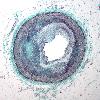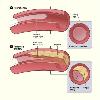

Low magnification wMicrograph Tags: Coronary Artery Disease View |
blood is then returned to the body The main aorta is clamped off cross clamped during CABG surgery to maintain a bloodless field and to allow bypasses to be connected to the aorta The most commonly used bypass vessel is the saphenous vein from the leg Bypass grafting involves sewing the graft vessels to the coronary arteries beyond the narrowing or blockage The Tags: Coronary Artery Disease View |
in the blood When plaque builds up in the arteries the condition is called atherosclerosis ATH er o skler O sis Atherosclerosis Figure A shows a normal artery with normal blood flow Figure B shows an artery with plaque buildup Plaque narrows the arteries and reduces blood flow Tags: Coronary Artery Disease View |
|||||||||
Coronary artery disease (CAD or atherosclerotic (atherosclerosis) heart disease) is the end result of the accumulation of atheromatous plaques (atheroma) within the walls of the coronary arteries (Coronary circulation)cite web url=title=Dorlands Medical Dictionary:coronary artery disease format= work= accessdate=2009-01-09 that supply the myocardium (the muscle of the heart) with oxygen and nutrients. It is sometimes also called coronary heart disease (CHD), but although CAD is the most common cause of CHD, it is not the only cause.
CAD is the leading cause of death worldwide. While the symptoms and signs of coronary artery disease are noted in the advanced state of disease, most individuals with coronary artery disease show no evidence of disease for decades as the disease progresses before the first onset of symptoms, often a "sudden" heart attack (myocardial infarction), finally arises. After decades of progression, some of these atheromatous plaques (atheroma) may rupture and (along with the activation of the blood clotting system) start limiting blood flow to the heart muscle (cardiac muscle). The disease is the most common cause of sudden death (cardiac arrest), and is also the most common reason for death of men and women over 20 years of age. According to present trends in the United States, half of healthy 40-year-old males will develop CAD in the future, and one in three healthy 40-year-old women. According to the Guinness Book of Records, Northern Ireland is the country with the most occurrences of CAD. By contrast, the Maasai of Africa have almost no heart disease.
As the degree of coronary artery disease progresses, there may be near-complete obstruction of the lumen (lumen (anatomy)) of the coronary artery, severely restricting the flow of oxygen-carrying blood to the myocardium. Individuals with this degree of coronary artery disease typically have suffered from one or more myocardial infarctions (heart attacks), and may have signs and symptoms of chronic coronary ischemia, including symptoms of angina (Angina pectoris) at rest and flash pulmonary edema.
A distinction should be made between myocardial ischemia and myocardial infarction. Ischemia means that the amount of blood supplied to the tissue is inadequate to supply the needs of the tissue. When the myocardium becomes ischemic, it does not function optimally. When large areas of the myocardium becomes ischemic, there can be impairment in the relaxation and contraction of the myocardium. If the blood flow to the tissue is improved, myocardial ischemia can be reversed. Infarction means that the tissue has undergone irreversible death due to lack of sufficient oxygen-rich blood.
An individual may develop a rupture of an atheromatous plaque at any stage of the spectrum of coronary artery disease. The acute rupture of a plaque may lead to an acute myocardial infarction (heart attack).
Icd10: ICD10I20i20-ICD10I25i20
Icd9: ICD9410-ICD9414, ICD9429.2
Emedicinesubj: radio
Emedicinetopic: 192
Meshid: D003324



